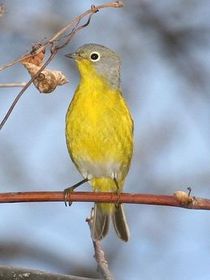Nashville Warbler
The Nashville Warbler, Vermivora ruficapilla, is a small songbird in the New World warbler family.

Original source: Nashville Warbler
Author: Dominic Sherony
The Nashville Warbler is classified as Least Concern. Does not qualify for a more at risk category. Widespread and abundant taxa are included in this category.
The Nashville Warbler, Vermivora ruficapilla, is a small songbird in the New World warbler family. They have olive-brown upperparts, a white belly and a yellow throat and breast; they have a white eye ring, no wing bars and a thin pointed bill. Adult males have a grey head with a rusty crown patch (often not visible); females and immature birds have a duller olive-grey head. More
Nashville warblers breed in open mixed woods and bog habitats in Canada and the northeastern and western United States of America. They conceal their open cup-shaped nests on the ground under shrubs. They migrate to southernmost Texas, Mexico and Central America in winter. They forage in the lower parts of trees and shrubs, frequently flicking their tails; these birds mainly eat insects. More
Nashville Warbler Range MapView dynamic map of eBird sightings Field MarksHelp - * AdultPopOutZoom In Adult * © Brian E. More
North American RangeThe Nashville Warbler is closely related to the Orange-crowned Warbler. The two species are similar in size and shape, but have distinct markings. Nashville Warblers have bright yellow undersides extending from their undertail coverts to their throats, and small white patches on their bellies. They have olive-green wings and light gray heads with distinct, white eye-rings. Males and females look similar, but the adult male has a rufous crown that is less distinct in the female. More
● Foraging & Feeding: Nashville Warbler: Eats mostly insects; forages by gleaning food from foliage, usually in mid-levels of a forest. ● Breeding & nesting: Nashville Warbler: Four or five white to creamy white eggs with small brown spots are laid in a cup of grass, leaves, and roots, lined with pine needles and fine grass, and concealed on the ground at the base of a bush or tussock of grass. Incubation ranges from 11 to 12 days and is carried out by both parents. More
The Nashville Warbler is a winter resident of Central America as far south as Costa Rica. Two races are generally recognized each breeding in two widely separated regions of North America. The eastern race breeds in northeastern North America and the western race in central western North America. More
WarblersThe Nashville Warbler is closely related to Virginia's Warbler, Lucy's Warbler and Colima Warbler, the four sharing generally similar plumage. References * BirdLife International (2004). Vermivora ruficapilla. 2006 IUCN Red List of Threatened Species. IUCN 2006. Retrieved on 12 May 2006. Database entry includes justification for why this species is of least concern Copyright: Wikipedia. More
The Nashville Warbler is closely related to Virginia's Warbler, Lucy's Warbler and Colima Warbler, the four sharing generally similar plumage. More
Status: The eastern race of Nashville Warbler (ruficapilla) is increasing or stable; slightly increasing in northern parts of its range.Western (ridgwayii) is stable. More
I vote for Nashville Warbler, although I agree with Ian that it's "exceptionally drab". I've never seen an Orange-crowned with such a distinct eye-ring, and the bird also lacks an eye-stripe, which should be evident on most if not all Orange-crowns. The bill also looks quite slight to me, which would fit Nashville better, although the measurements in "Birds of Canada" suggest that the difference in bill length is quite small. Wayne C. More
Warblers, I was surprised to find that when the Nashville Warbler was first discovered, and for a number of years following in the 1800’s, it had been considered a rare species. It was something of a shock to learn that this was an “edge” species; edge is where two habitats abut each other, such as the junction between forest and meadow. In the 1800’s Canadian forests were not as fragmented as today. Most warbers are not benefited by fragmentation of habitat, but apparently the Nashville Warbler is—the exception to the rule. More
This Nashville Warbler was searching through cherry blossoms to find insects. They also feed on leafhoppers, weevils and spiders. In 1811, Alexander Wilson discovered this species while it was passing through Nashville and named it the Nashville Warbler. He saw this species three times during his life. During the same time period, other well-known birders also chanced upon seeing the bird only a few times. Then to everyone's surprise, by 1879, more and more sightings of Nashville Warblers started being reported. More

Original source: dominic sherony
Author: dominic sherony
Permission: Some rights reserved
Family : Parulidae
Genus : Vermivora
Species : ruficapilla
Authority : (Wilson, 1811)
